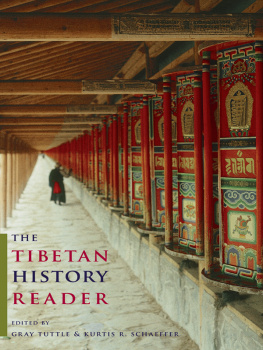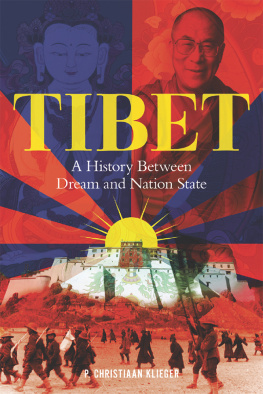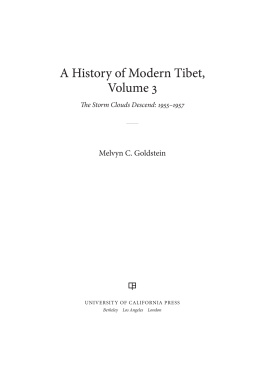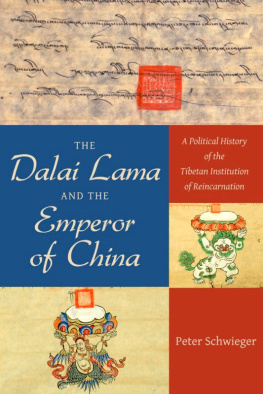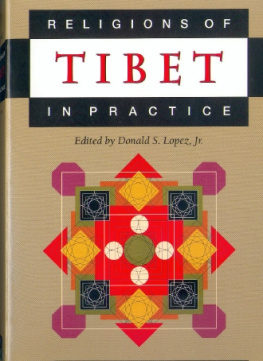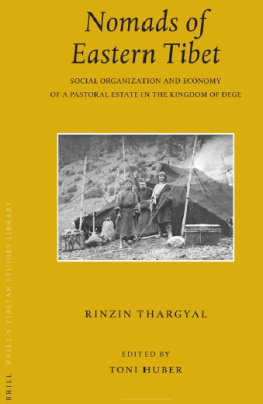The Tibetan History Reader
The Tibetan History Reader
Edited by Gray Tuttle and Kurtis R. Schaeffer
COLUMBIA UNIVERSITY PRESS
NEW YORK
A special thank you to the Shelley & Donald Rubin Foundation for crucial financial support for the publication of this book.
Columbia University Press
Publishers Since 1893
New York Chichester, West Sussex
cup.columbia.edu
Copyright 2013 Gray Tuttle and Kurtis R. Schaeffer
All rights reserved
E-ISBN 978-0-231-51354-8
Library of Congress Cataloging-in-Publication Data
The Tibetan history reader / Gray Tuttle and Kurtis R. Schaeffer, editors.
p. cm.
Includes bibliographical references and index.
ISBN 978-0-231-14468-1 (cloth : alk. paper)ISBN 978-0-231-14469-8 (pbk.)ISBN 978-0-231-51354-8 (electronic)
1. Tibet RegionHistory. 2. Tibet RegionCivilization. 3. Tibet Autonomous Region (China)History. I. Tuttle, Gray. II. Schaeffer, Kurtis R.
DS785.T495 2013
A Columbia University Press E-book.
CUP would be pleased to hear about your reading experience with this e-book at .
References to Internet Web sites (URLs) were accurate at the time of writing. Neither the author nor Columbia University Press is responsible for URLs that may have expired or changed since the manuscript was prepared.
To Shelley and Donald Rubin for their generous support for Tibetan studies.
May it lead even more students and learners to greater understanding of Tibet and the Himalayas.
CONTENTS
The Tibetan History Reader assembles crucial studies of Tibetan history, organized in a comprehensive chronological framework, to make available concise yet detailed essays drawn principally from the last half-century of Tibetan studies, most of which have been inaccessible to a general audience. Emphasizing political, social, and cultural history, this book is designed to introduce Tibet to university courses on Asian studies, religious studies, and world civilizations. It is our hope that the Reader becomes the first place to which students and scholars of Asia turn when seeking accurate, in-depth information about the history of Tibet.
This volume complements another volume published by Columbia University Press, Sources of Tibetan Tradition (edited with Matthew Kapstein). Where Sources provides translations of important Tibetan works of literature, the Reader adds important essays on specific aspects of Tibetan civilization, so they work in concert featuring translated texts and authoritative studies.
The Reader follows a chronological and regional outline, surveying the political and institutional history of Tibet from its emergence as an imperial power in the seventh century to the profound transformations of the modern period. Each section strikes a balance between the general and the specific, emphasizing broad historical trends through choice essays on specific topics.
There has long been a need for current, detailed, and readable materials for teaching about Tibet as part of the Asian humanities curriculum in North American colleges and universities. The Reader is designed to make the veritable explosion of research about Tibet in the last three decades readily accessible in the college classroom, as well as to scholars in other fields who need to consult authoritative studies of Tibet. Tibetan history is a very international endeavor, as can be seen by the diverse contributions here of Americans, Chinese, French, Germans, Italians, Japanese, a Norwegian, and Tibetans. To help bring this vast scholarly knowledge to a general audience, Tibetan personal and place names have been rendered in an easy-to-pronounce phonetic system based on the Tibetan and Himalayan Library (THL) standard developed by David Germano and Nicolas Tournadre. Chinese transliterations have been rendered in Pinyin. Some effort has also been made to standardize the Mongol terms and names, according to the system used in Christopher Atwoods Encyclopedia of Mongolia and the Mongol Empire (New York: Facts on File, 2004). All notes have been converted to endnotes, and in general, we have left the Tibetan spellings in the notes as in the original, whether in phonetics (now standardized in the THL phonetics) or Wylie transcriptions. Moreover, the complex and sometimes cryptic references to cited works have been standardized here according to Columbia University Press style. This has sometimes altered the appearance or formatting of the original articles; however, the full citation of the original will lead interested readers to the Tibetan Wylie transcription as well as the original footnotes or parenthetical references. All bibliographic references have been collected at the end of the book.
The work of making these changes was much more extensive than we initially realized it would be, so we have many people to thank. First, our editor, Anne Routon, deserves special thanks for her consistent support of Tibetan studies in general and this project in particular. Funding from the Shelley & Donald Rubin Foundation has been absolutely essential to completing this volume, and we are very grateful to the Rubins as well as Bruce Payne and Alex Gardner for their visionary assistance. In preparing the manuscript for this volume, Ulan, in Tibetan Studies at Columbia University, has played the key role, especially in standardizing the bibliographies; translating the Chinese, Japanese, and German bibliographic references; and generally keeping track of changes and resolving outstanding issues. Stacey Van Vleet, also at Columbia University, and Lindsey Sekreve, at the University of Virginia, tackled the massive task of converting all the Tibetan transcriptions into phonetics and standardizing the Chinese as Pinyin. Geoff Barstow, Benjamin Deitle, and William McGrath at the University of Virginia provided critical assistance at the later stages of the editing, taking several of the most challenging articles through many layers of editing. Finally, thanks are due to Leslie Kriesel for copyediting (and much more) and to Cynthia Col for indexing. We are being quite literal when we say that without the expert assistance of everyone involved in this project, it would never have been completed. Thank you to all!
before c. 600 C.E. | prehistoric and legendary period |
247 B.C.E. | traditional dating of Nyatri Tsenpos election as king |
202 B.C.E.220 C.E. | Han empire extends Chinese power in Inner Asia |
433 C.E. | traditional dating of first intimations of Buddhism in Tibet, under King Lha Totori |
3241453 | Byzantine empire |

